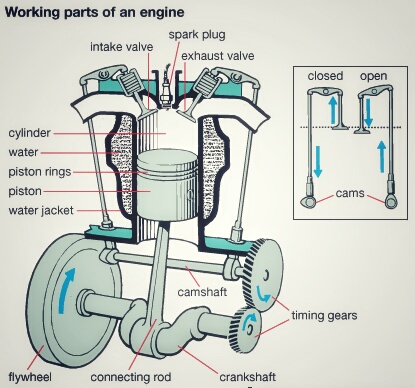Components of an Engine:
Even though reciprocating internal combustion engines look quite simple, they are highly complex machines. There are hundreds of components that have to perform their functions satisfactorily to produce output power. There are two types of engines, viz., spark ignition (S1) and compression- ignition (CI) engine. Let us now go through the important engine components and the nomenclature associated with an engine.
Terms connected with i.c. engines:
1. Bore: The inside diameter of the cylinder is called bore
2. Stroke: The linear distance along the cylinder axis between two limiting position s is called stroke.
3. Top Dead Center (T.D.C.): the top most position of the piston towards cover end side of the cylinder is called T.D.C.
4. Bottom dead Center (B.D.C.): The lowest position of the piston towards the crank end side of the cylinder is called B.D.C.
5. Clearance Volume: The volume contained in the cylinder above the top of the piston, when the piston is at top dead center, is called the clearance volume.
6. Swept Volume: The volume swept through by the piston in moving between T.D.C. and B.D.C, is called swept volume or piston displacement.
7. Compression Ratio: It is the ratio of Total cylinder volume to clearance volume
Definition of ‘Engine’
An engine is a device, which transforms one form of energy into another form. Normally, most of the engines convert thermal energy into mechanical work and therefore they are called ‘heat engines’.
Engine Components:
The major components of the engine and their functions are briefly described below. Cylinder Block:
The cylinder block is the main supporting structure for the various components. The cylinder of a multi cylinder engine is cast as a single unit, called cylinder block. The cylinder head is mounted on the cylinder block.The cylinder head and cylinder block are provided with water jackets in the case of water-cooling with cooling fins in the case of air- cooling. Cylinder head gasket is incorporated between the cylinder block and cylinder head. The cylinder head is held tight to the cylinder block by number of bolts or studs. The bottom portion of the cylinder block is called crankcase. A cover called crankcase, which becomes a sump for lubricating oil is fastened to the bottom of the crankcase. The inner surface of the cylinder block, which is machined and finished accurately to cylindrical shape, is called bore or face.
Cylinder:
As the name implies it is a cylindrical vessel or space in which the piston makes a reciprocating motion. The varying volume created in the cylinder during the operation of the engine is filled with the working fluid and subjected to different thermodynamic processes. The cylinder is supported in the cylinder block.Piston:
It is a cylindrical component fitted into the cylinder forming the moving boundary of the combustion system. It fits perfectly (snugly) into the cylinder providing a gas-tight space with the piston rings and the lubricant. It forms the first link in transmitting the gas forces to the output shaft.Combustion Chamber:
The space enclosed in the upper part of the cylinder, by the cylinder head and the piston top during the combustion process, is called the combustion chamber. The combustion of fuel and the consequent release of thermal energy results in the building up of pressure in this part of the cylinder.Inlet Manifold:
The pipe which connects the intake system to the inlet valve of the engine and through which air or air-fuel mixture is drawn into the cylinder is called the inlet manifold.
Gudgeon Pin:
It forms the link between the small end of the connecting rod and the piston. Exhaust Manifold:
The pipe that connects the exhaust system to the exhaust valve of the engine and through which the products of combustion escape into the atmosphere is called the exhaust manifold.regulating the charge coming into the cylinder (inlet valve) and for discharging the products of combustion (exhaust valve) from the cylinder.
Connecting Rod It interconnects the piston and the crankshaft and transmits the gas forces from the piston to the crankshaft. The two ends of the connecting rod are called as small end and the big end. Small end is connected to the piston by gudgeon pin and the big end is connected to the crankshaft by crankpin.
Crankshaft:
It converts the reciprocating motion of the piston into useful rotary motion of the output shaft. In the crankshaft of a single cylinder enginethere is pair of crank arms and balance weights. The balance weights are provided for static and dynamic balancing of the rotating system. The crankshaft is enclosed in a crankcase.






















